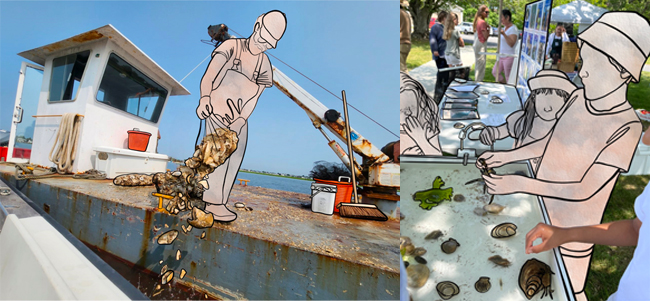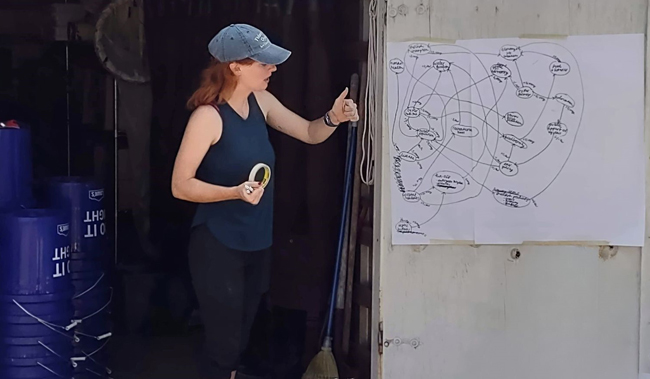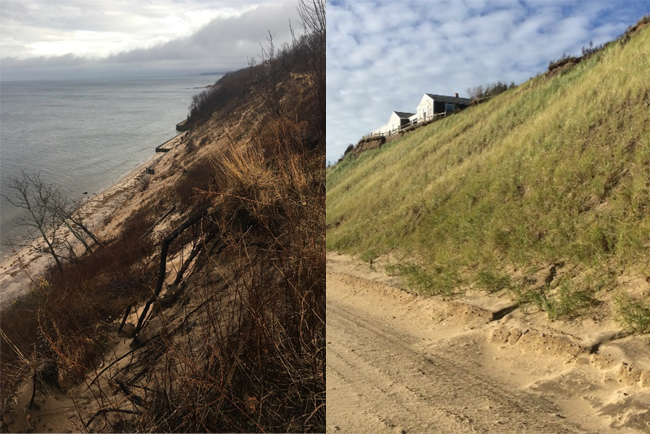— by Alisa D’Souza, freelance writer
Stony Brook, NY, May 15, 2024 - Outside it may have been a rainy day with gray and cloudy skies, but inside the Waterview in Port Jefferson, New York, spirits were bright and riveting conversations were alight as research scientists, Sea Grant officials, city planners, and policymakers alike all gathered for the 2024 Long Island Sound Research Conference.
The importance of “Science Serving the Sound” was the running theme for the conference, a joint effort between New York Sea Grant, Connecticut Sea Grant, and the Long Island Sound Study. First occurring in 1992, this biennial conference allows for research scientists and professionals to share research and science occurring around the Long Island Sound (LIS, or the Sound), and was last held on Long Island in 2019. The day began with welcoming remarks from Dr. Rebecca Shuford (director of the NY Sea Grant), Dr. Sylvain de Guise (director of the CT Sea Grant), and Dr. Mark Tedesco (director of the Long Island Sound Study office of the U.S. Environmental Protection Agency).
Throughout the day, attendees chose from four parallel sessions totaling 54 oral presentations as well as an atrium of 32 poster presentations, a panel discussion, and a lunchtime plenary talk given by Dr. Phil Levin, from the White House Office of Science and Technology Policy and U.S. Global Change Research Program.
Talks and poster presentations followed the four main themes of the conference, including: Clean Waters and Healthy Watersheds; Sound Science and Inclusive Management; Sustainable and Resilient Communities; Thriving Habitats and Abundant Wildlife. Each theme represents an important aspect of protecting the Long Island Sound and reflects the goal of the conference and its attendees.
Below are summaries and key takeaways from select presentations for each theme, as well as overviews from the panel discussion, plenary talk, and poster presentations. This is not all-encompassing, so please check out the conference agenda and abstract booklet for more details. As readers will find, some of the presentations overlap themes and tend to agree, regardless of their specific themes, that engagement and interest in science and the Sound from communities, policymakers, and citizens will be crucial for the future.
Presentations under the "Clean Waters and Healthy Watersheds" theme included examinations of bioextraction efficiency and techniques, the filtering and health of bivalves, water quality, and the management and modeling techniques for understanding nutrient concentrations and assessing the health of waters.
In the study “Maximizing Nitrogen Bioextraction in Long Island Sound via the co-Cultivation of Seaweeds with Bivalves”, Michael Doall and Dr. Christopher Gobler analyzed the relationship between kelp and oysters in their nitrogen bioextraction potentials. Pairing the two organism types showed to be valuable due to higher kelp growth and faster oyster growth both leading to greater nitrogen bioextraction. The kelp growing season extends from December through May, and the oyster season is between June through October, so integrating the two allows for more nitrogen removal benefits.
Another presentation on the theme outlined the benefits of satellite remote sensing observations in oceanography. Though it was a cloudy day not ideal for satellite observations, the usefulness of satellite data for a myriad of water quality monitoring efforts shone through in a presentation by Dr. Jonathan Sherman from NOAA CoastWatch and Global Science and Technology Inc. In Long Island Sound, there are vast ecological and economic prospects, however, there are also various threats including hypoxia, degraded water clarity, eutrophication, and harmful algal blooms. With satellite observations, researchers can monitor and understand the dynamics and variability of key biological and geochemical components across the entire ecosystem, over different seasons, and across a range of conditions. NOAA CoastWatch is dedicated to helping a wide range of users to select and access such satellite datasets.
In the "Sound Science and Inclusive Management" theme, presentations discussed not only monitoring and mapping methods for studying the seafloor, water quality, suitable habitat availability, and the health of waters and organisms with various climate-related issues, but also how we may improve management practices and bridge the gap between science, management and policy.

Anonymized photographs from the Photovoice data in Dr. Drew’s research. Credit: Grace Grimes
Dr. Joshua Drew’s (SUNY College of Environmental Science and Forestry) work titled “Stakeholder Perceptions of Oyster Services: A Mixed Methods Approach to Mapping Services to Improve Management Efficiency,” surveyed stakeholders along Long Island using a “Fuzzy Cognitive Mapping” technique to understand what community members valued most about oysters. Participants expanded upon this data, using a second method called “Photovoice,” which allows community members to take photos reflecting their relationships with and uses for oysters, to understand and bring to life the purpose of this research. Results reflected a wide range of ecosystem services provided by oysters, including water quality improvement through filter feeding, job opportunities, economic benefits, contributions to biodiversity, and educational opportunities. Results also indicated that there are human-environment conflicts with oyster aquaculture areas and gear posing boating hazards or distractions to prospective builders and coastal homeowners. Despite the dissensus in oyster management, the researchers noted that there was a lot of overlap and potential for a more collaborative future with oysters.

The Fuzzy Cognitive Mapping model in process. Credit: Grace Grimes
In a panel discussion moderated by Dr. Mark Tedesco, panelists Nancy Seligson (co-chair of the LISS Citizens Advisory Committee of NY), Brian Thompson (CT Dept of Energy and Environmental Protection), Bill Lucey (Long Island Soundkeeper of Save the Sound), Jonathan Hoffman (NYC Dept of Environmental Protection) were asked a series of questions regarding their opinions on the progress of management, policy, and research pertaining to the LIS, barriers, gaps, and advancements in information and communication, and steps moving forward. These questions were also opened up to the audience for further discussion and welcome contributions. Below are some of the questions asked, along with some of the responses from the panelists and audience members.
Panelist responses have been summarized and identified by a “P”, and audience responses are summarized and marked with an “A”.
MT: What are some of the greatest successes and failures in the management of the Long Island Sound?
P: The conference itself reflects many people coming together with a shared goal for better water quality and ecosystem health in the LIS. Upgrades in wastewater treatment and nitrogen credits and reduction (including from affluents) were also noted as successes. Work still to be done includes data organization, better policy to protect watersheds from the impacts of warming and fertilizer usage, attention towards non-point-source areas (which are less studied), and applications to and involvement of the public in research efforts.
A: The audience echoed the concerns for better policy and also noted the need for addressing sea level rise and declines in both species and natural resources, but stated that research funding has increased.
MT: What specific developments from research to policy have occurred?
P: Seafloor mapping is particularly useful to guide the development of underwater cables and offshore wind technology. There has also been good funding for research directed towards solving problems with eelgrass and lobsters and there is an emphasis on hypoxia and oxygen levels in the Sound.
MT: What aspects of other coasts would you envy or like to emulate, and what do you think stops us on the LIS from surpassing those other coasts?
P: Nature-based solutions are critical and would be valuable, and a sense of belonging, identity with, and political support of the LIS would also be great to have. Other coasts tend to have more passion for and connection with their waters, which we should hope to emulate.
A: Public access to Long Island beaches!
MT: Which issues have a gap between the decisions made and the science information?
P: While we are working on integrating the social sciences and natural sciences, and public involvement with the Sound, more work is yet to be done. A collection of relevant data into an accessible database would also be useful to easily get and make use of existing data.
A: Marine debris and plastic input are concerns for what is shown scientifically, versus what problems persist in our environment.
MT: What excites you about the advancements in science and technology?
P: AI, adaptive management, GIS, better materials (non-plastics), and civic involvement in politics to encourage policies provide reasons for excitement towards the future.
MT: What are some of the issues/barriers with community engagement in marine sciences research?
P: The privatization of beaches can be a barrier as people can reject policies proposed if they would like to maintain their own beaches.
During the lunch break, Dr. Phil Levin gave the plenary talk on “Moving Knowledge to Action for People and Nature: Musings from a Recovering Ecologist” detailing data from the Puget Sound with applications to the Long Island Sound.
Levin highlighted that when scientific information and data are collected into actions, it is critical to have relationships and trust with the public and to not only answer the questions that have been asked, but to explore those that have not yet been asked. With runoff from stormwater, Puget Sound has been polluted with oil, copper, and zinc from cars, trucks, and animal feces, which leads to the decline in populations of invertebrates, seagrass, and salmon, as well as reduced marsh health. Species passing by (such as salmon and orcas) are also at a detriment and can face pre-spawn mortality or defects in offspring. While most toxins present in the orcas and salmon are not from Puget Sound, due to their large range over their life, native and local species are at stake. Marine pollution hotspot maps can help prioritize which areas need most pertinent attention, by comparing data on species abundance and urbanization, and relating this to U.S. Census data to help the local human populations as well.
Dr. Levin also recognized that there can be differing goals and methods when approaching an issue, and this can create conflicts between people or organizations if unaddressed. He advised that as Sea Grant moves forward with conservation efforts, it should consider ecosystem health, human well-being, resource management, development costs, nature-based solutions, and multiple ways of knowing and cultural practices as the potential viewpoints for required actions. Further, relevance and an emotional connection should be emphasized, with information being spread not only through conferences and research articles but through poetry, dance, film, and other forms of media so that we foster a society that cares about and relates to these topics and feels involved and connected.
The "Sustainable and Resilient Communities" theme highlighted coastal features, the stabilization and protection of coasts, and the importance of community engagement and involvement with our oceans. Other presentations in the theme discussed the accessibility of beaches along Long Island, surveys of identity and connection with the ocean, and protection from microplastics, marine debris, and floods.
Dr. Kathleen Fallon from NY Sea Grant discussed Long Island’s coastal bluffs and what makes the threat of erosion particularly important for areas with coastal bluffs, as compared to sandier beaches in depositional environments. Erosion is present on both the south and north shores, removing sediments and transporting them offshore. As wave energy settles down, beaches can recover from erosion through nourishment by the returning sediments that were carried away. However, this recovery tends to occur more easily on sandier beaches, such as along the south shore. On coastal bluffs, such as along the north shore of Long Island, while erosion can still provide nourishment, the reconstruction methods can be more complex. Instability along bluffs, such as an exceeded angle of repose or lack of supportive vegetation, can contribute to erosion, as can storm surges and other large erosion events. Community members, typically homeowners, can reach out to NY Sea Grant if erosion is something of concern or interest to them, and NY Sea Grant can advise and discuss solutions such as added vegetation or stabilization to the toes of the bluffs.

Left: Vegetation along a coastal bluff helps provide support and take in water runoff to avoid collapses. Credit: Dr. Kathleen Fallon; Right: Ample vegetation along the shoreline provides support and protection for structures (such as houses seen in the image). Credit: Siasconset Beach Preservation Fund
Dr. Miriah M.R. Kelly and Graham Templeman of Southern Connecticut State University gave a presentation on the Ocean Identity Survey and its relevance, and the Ocean Identity Survey’s pilot program using Project Limulus (respectively). The presentations highlighted that while there is ample scientific research for ocean and coastal issues, an opportunity exists for an integration of the social and natural sciences through a greater understanding of how people connect with the ocean. A sense of belonging with and attraction to the ocean, concern for the ocean, and personal expression are all areas where engagement with the ocean can occur; it does not always have to be through formal education, so this offers an area for insight into how ocean literacy can be developed and how engagement in the sciences can occur non-traditionally. After much development in the survey, a pilot survey is ready to be administered to a group of participants from Project Limulus (a citizen science initiative studying horseshoe crabs) to help iron out the survey and its accompanying toolkit.
The "Thriving Habitats and Abundant Wildlife" theme focused on the protection and restoration of habitats and health of organisms (including keystone species) in the LIS. Presentations included examinations of how elements such as bathymetry, saltmarsh health, underwater imagery and human impact analyses can impact saltmarsh sparrows, shellfish and bivalves, fish species such as alewives and black sea bass, and more.
David Riser from the University of Connecticut shared the increases in the black sea bass populations in the Long Island Sound. In just 10 years, black sea bass populations have increased from mere tens to thousands. Black sea bass start out as hermaphrodites, then develop into males, with most adults found as males after a certain body length and age. As they age, they also require deeper water depths, so they leave the Long Island Sound.
Alewife, on the other hand, are not so lucky in their mobility prospects. In “Is Drought the New Fad Diet? Effect of Entrapment on Size, Body Condition, and Growth Rates of Juvenile Anadromous Alewives,” Dr. Eric Schultz detailed the decline in alewife fish populations and in their ability to migrate and maintain habitat connectivity. The fish, which are typically abundant, have now become threatened due to issues such as the presence of dams and drought. Fish ladders and dam removals may be useful to promote habitat connectivity and help the alewives complete their spawning migration, though drought is a trickier issue for the juveniles left behind. With drought, alewives were found to grow slower and have less energy intake, and if drought persists, this may result in smaller, skinnier alewives and reduced alewife populations. All this reflects the importance of protecting habitats and habitat connectivity to restore and protect the alewive populations. Other presentations in the theme also brought up the value of protecting habitats and species.
The 2024 conference, with its four key themes, more than 80 total presentations, and even a change of venue (graciously assisted by Danford’s and The Waterview of Port Jefferson, NY), reflected many advancements in and hopes for marine sciences. This includes the natural science research aspects, community and citizen engagements, the intersection between the natural and social sciences, and future steps to conserve our waters, including the Long Island Sound. Some key takeaways from the conference include the positives of agreement between researchers to understand and protect the Sound and developments in opportunities for people to enjoy natural resources and feel connected to the environment and their community. Takeaways for areas of improvement and next steps include encouraging care and greater involvement of the public in research efforts, making information accessible and understandable for the public, and sufficient funding for those involved with marine research.
More Info: New York Sea Grant
Established in 1966, the National Oceanic and Atmospheric Administration (NOAA)’s National Sea Grant College Program promotes the informed stewardship of coastal resources in 34 joint federal/state university-based programs in every U.S. coastal state (marine and Great Lakes) and Puerto Rico. The Sea Grant model has also inspired similar projects in the Pacific region, Korea and Indonesia.
Since 1971, New York Sea Grant (NYSG) has represented a statewide network of integrated research, education and extension services promoting coastal community economic vitality, environmental sustainability and citizen awareness and understanding about the State’s marine and Great Lakes resources.
NYSG historically leverages on average a 3 to 6-fold return on each invested federal dollar, annually. We benefit from this, as these resources are invested in Sea Grant staff and their work in communities right here in New York.
Through NYSG’s efforts, the combined talents of university scientists and extension specialists help develop and transfer science-based information to many coastal user groups—businesses and industries, federal, state and local government decision-makers and agency managers, educators, the media and the interested public.
New York Sea Grant, one of the largest of the state Sea Grant programs, is a cooperative program of the State University of New York (SUNY) and Cornell University. The program maintains Great Lakes offices at Cornell University, SUNY Buffalo, Rochester Institute of Technology, SUNY Oswego, the Wayne County Cooperative Extension office in Newark, and in Watertown. In the State's marine waters, NYSG has offices at Stony Brook University and with Cornell Cooperative Extension of Nassau County on Long Island, in Queens, at Brooklyn College, with Cornell Cooperative Extension in NYC, in Bronx, with Cornell Cooperative Extension of Ulster County in Kingston, and with Cornell Cooperative Extension of Westchester County in Elmsford.
For updates on Sea Grant activities: www.nyseagrant.org, follow us on social media (Facebook, Twitter/X, Instagram, Bluesky, LinkedIn, and YouTube). NYSG offers a free e-list sign up via www.nyseagrant.org/nycoastlines for its flagship publication, NY Coastlines/Currents, which it publishes 2-3 times a year.